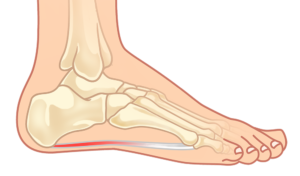Myths of Plantar Fasciitis
If you are dealing with pain caused by plantar fasciitis, you know how frustrating it can be. There are many misconceptions about this condition that remain prevalent, and we’d like to break down a few plantar fasciitis myths.

Plantar Fasciitis Myths
Here are the most common plantar fasciitis myths we hear.
Plantar Fasciitis Myth #1:
Heel Spurs and Plantar Fasciitis are the same thing.
It is a common misconception that if you have plantar fasciitis you also have heel spurs and vice versa. However, these are two very distinct conditions and are treated very differently. This is one of the more common plantar fasciitis myths.
First of all, let’s look at the most common of the two – plantar fasciitis. The plantar fascia is a dense connective tissue. It fans from the bottom of the heel bone to the base of the toes. Plantar fasciitis is a condition where there is damage to the plantar fascia, usually near the point that it attaches to the heel.
Factors that apply excessive strain, such as obesity, overuse, poor foot mechanics, improper footwear, cause plantar fasciitis. Most treatments of plantar fasciitis are conservative in nature, including custom orthotics, physiotherapy, activity modification, icing, stretching and rest.
On the other hand, heel spurs result from calcium deposits on the heel, above the attachment of the plantar fascia. In most cases, heel spurs do not cause any pain and have no negative effects on a person’s daily life. As well, specialists find many spurs during an examination of other conditions of the heel or foot. THey are not that actual cause of the plantar fasciitis itself.
Likewise, a few common treatments of painful heel spurs include custom orthotics, accommodative pads, NSAIDs and, in extreme cases, surgery.
Plantar Fasciitis Myth #2:
Minimalist style running will prevent, or even cure, plantar fasciitis.
Next, there was a lot of talk about how minimalist – or barefoot – running could cure plantar fasciitis in the early days of the minimalist running trend. Supposedly, minimalist running would strengthen the intrinsic muscles of the feet. But this is one of the most persevering plantar fasciitis myths.
Further, many of these claims were highly anecdotal and did not have any actual scientific claims to back them up. As science caught up to the popularity of minimalist running, researchers published studies showing no evidence of running in minimalist footwear reducing plantar fasciitis, or any other musculoskeletal injury.
In fact, everybody has a unique running style. For that reason, it’s far too simple to say that one running method will work for the majority of people.
Plantar Fasciitis Myth #3:
Only athletes get plantar fasciitis.
Finally, plantar fasciitis affects most facets of the population. There are many causes of plantar fasciitis and athletic stress isn’t the only factor. Poor foot mechanics, improper footwear, overuse, obesity and poor environmental conditions are all factors that can contribute to plantar fasciitis.
Furthermore, almost every person on the planet is susceptible to developing plantar fasciitis. So, it is important to seek professional footwear and foot care advice that suits your activity, employment and lifestyle. The belief that only active people develop this condition is another one of the more well-known plantar fasciitis myths.
Talk To A Specialist
Plantar fasciitis myths are surprisingly common, and we recommend speaking to a specialist about this condition. They will be able to break down the facts about this condition. As well, they can create a custom treatment plan just for you.
Sorry, the comment form is closed at this time.